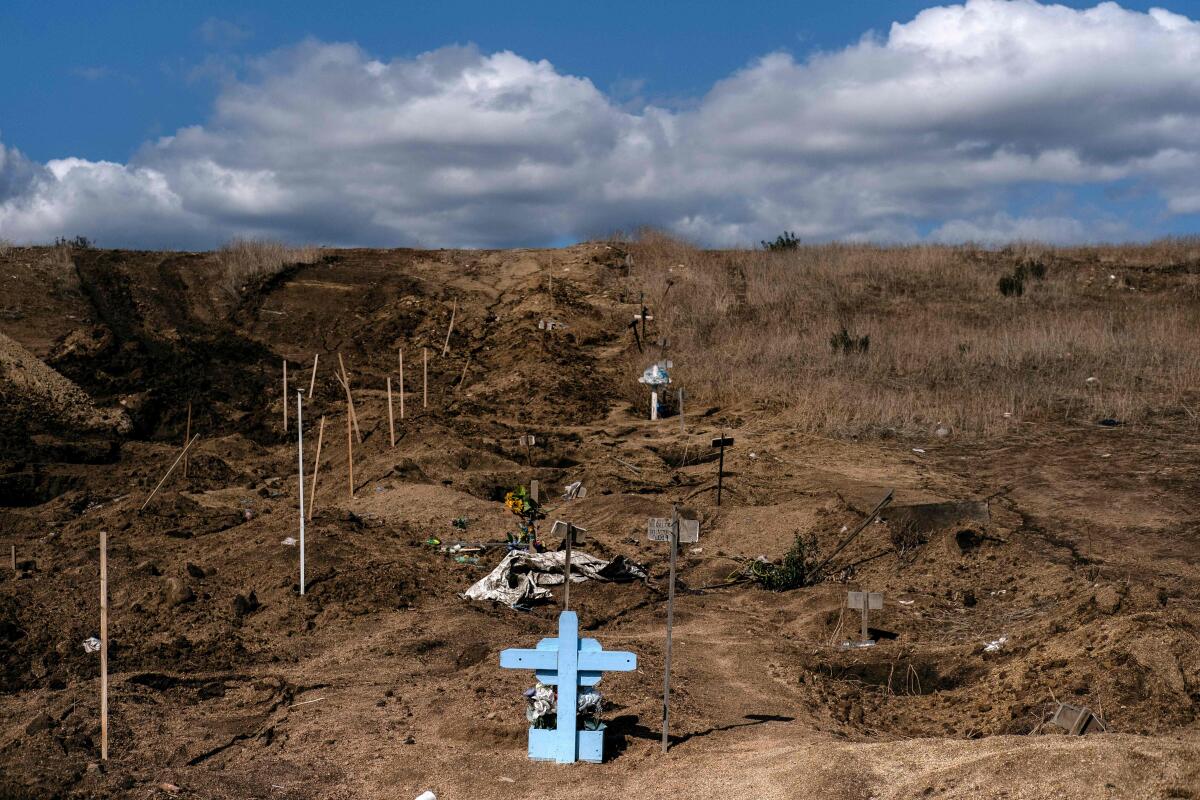Tijuana still Mexico’s bloodiest city despite drop in homicides. Blame drug violence

- Share via
TIJUANA — Tijuana once again topped the list as the city in Mexico with the highest number of homicides in 2019, surpassing other municipalities across the country by hundreds of killings.
The city closed out the year with approximately 2,185 homicides — a reduction of about 321 slayings from the record-breaking 2018, which earned Tijuana the title of most violent city in the world by a Mexican nonprofit advocacy group.
It’s the second year in a row there have been more than 2,000 homicides in this border city of about 1.8 million people where small-time dealers fight and die for the right to sell drugs to a growing local market. Tijuana has also long been the battleground for international drug-trafficking organizations fighting for control of routes to the U.S.
On Tuesday, the last day of the year, the body of a young man between 25 and 30 years old was found around noon on Miguel Hidalgo Avenue in the Colonia 3 de Octubre neighborhood. He had been shot in the head, according to local police. Later in the afternoon, a man at the General Hospital of Tijuana succumbed to gunshot wounds he sustained earlier in the week.
Those two homicides were the last reported in 2019, but sometimes the final numbers tick up because more victims are either discovered or identified after year’s end.
Mexico’s Secretary of Public Safety Alfonso Durazo said at a news conference in mid-December that a special strategy backed by the newly-formed national guard and the Mexican army has managed to slightly reduce the number of homicides in Tijuana. He said the strategy includes patrolling high-conflict zones within the city and manning checkpoints.
The trend is continuing downward, though that might not yet be fully reflected by the high year-end totals, he said.
For example, the death toll was two on Dec. 31, 2019, compared with seven on the last day of 2018.
“That figure that had reached 24 homicides a day has gone down. Usually, [now] it is at three, four and sometimes it shoots at five cases ... but we continue with the commitment to reduce them because even one homicide seems too high of a figure,” said Durazo.
Carlos Flores, commissioner of the State Security and Investigation Guard for Baja California, said that the high number of homicides in Tijuana pushed the state to No. 2 for homicides in Mexico for 2019.
“Tijuana has been representing between 70% to 75% of the problem [in Baja California], so our main focus is here,” said Flores. “When we talk about a second place, that is Ensenada, but it is a very far second place,” said Flores. Officials reported slightly more than 250 homicides in Ensenada in 2019.
The total number of homicides for Baja California was 2,841 as of Dec. 27, according to Flores.
Though prosecutors were encouraged by any small dent in the skyrocketing homicide trends, Flores acknowledged they were not yet satisfied with their results, which he said “were obviously still way too high.”
He said there has been a 57% increase in arrest warrants issued in homicide cases last year compared with 2018.
Authorities are trying to fight criminal groups by charging all those who may be associated with a homicide, rather than just the person who pulled the trigger. But, in a country where just one in 10 homicides are solved and the conviction rate is less than 6%, it’s an uphill battle.
“We are focusing on fighting impunity in this crime,” Flores said.
According to data from Mexico’s National Institute of Statistics and Geography, the country had 154,557 homicides between 2010 and 2016, and in 95% of those cases, no one has been convicted. In Baja California, 6,443 people were slain during the same period and just 252 people were sentenced for those crimes — less than 4%.
Investigators said the root cause of the bloodshed follows trends from 2018 with lower-level drug dealers battling over street corners to control the local methamphetamine market in Tijuana.
Law enforcement officials also say the rise of the Cartel Jalisco Nueva Generación, or CJNG, which has gained power by forging alliances with remnants of the once-powerful Arellano Felix Cartel, has contributed to the violence. This summer, the organization unsuccessfully tried to seize complete control of Tijuana from the weakened Sinaloa Cartel after the downfall of its leader, Joaquín “El Chapo” Guzmán.
A March 2018 policy report from the University of San Diego’s Justice in Mexico project described the CJNG as “an offshoot of the Sinaloa Cartel that has managed to rebrand itself, consolidate splintered criminal networks and emerge as one of the most powerful drug trafficking organizations in Mexico.”
Fry writes for the San Diego Union-Tribune.
More to Read
Sign up for Essential California
The most important California stories and recommendations in your inbox every morning.
You may occasionally receive promotional content from the Los Angeles Times.










